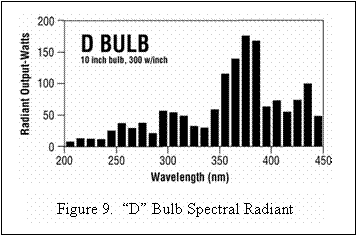Guide to UV Measurement
Spectral OutputThe distribution of the spectral power output of three different high power bulbs is shown in Figure 8, Figure 9, and Figure 10. By summarizing the spectral output power distribution in bands of 10 nm wavelength and plotting using the center wavelength of each band, a very reproducible and easy to analyze spectral output chart can be made. The “H” spectrum at 300 watts per inch is displayed in Figure 8. Figure 9 shows the “D” spectrum at 300 watts per inch. By inspection of Figure 9, the significant enhancement of the “D” spectrum in the 350 to 400 nm range is apparent, as is the enhancement in the 400-450 nm range of the “V” bulb (Figure 10). These different spectral output bulbs can produce varying curing results in different inks and coatings. Specifically, the “H” spectrum of Figure 8 is effective in producing hard surface cures and high gloss finishes. The “D” spectrum of Figure 9, because of the greater penetration of the longer wavelength UV, is preferred for curing pigmented materials (inks) and thick sections of clear materials. The “V” spectrum of Figure 10 is especially suited to curing white inks and basecoats which typically containing high loadings of TiO 2 . In the case of the microwave powered lamp, owing to the fact that no chemical interactions with electrodes occur, the relative concentrations of fill additives do not change. Consequently, its spectral output remains unchanged with continued use. |
 |
 |
|
 |